










October 2024, no. 141
Create a MARIN account to stay updated

Report

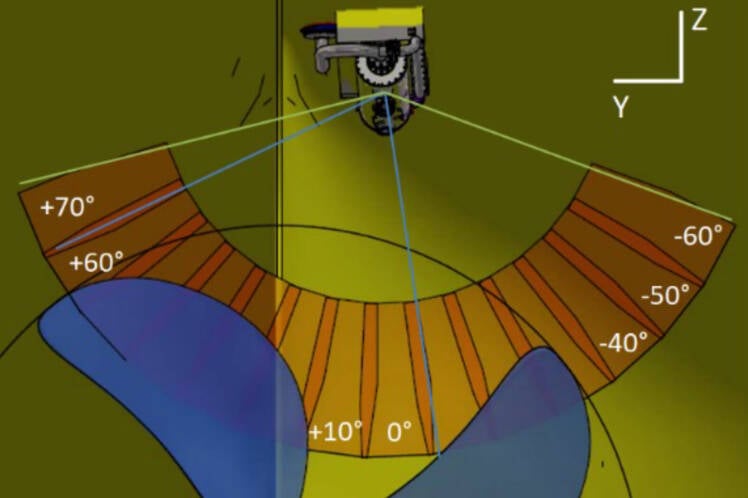



Nov.
19-20
HISWA Symposium
Conferences
Nov.
18-22
Floating Energy Research
Forum
Networking
Nov. 7
SmartPort Summit water & De haven
Seminars
Nov.
4-6
Hydrodynamics of Floating Offshore Structures
Cources
MARIN will be present at the following events. Let’s meet up again soon!
MARIN presentation on the TopTier project’s results during the CCC (10) plenary meeting.
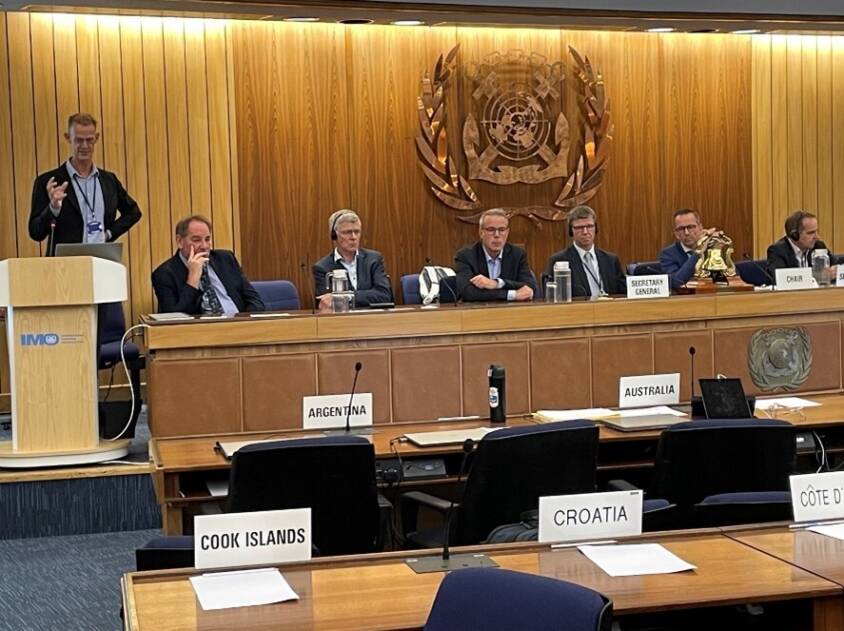









Back to In Short
Prevention of container losses at the IMO
The IMO Sub-Committee on the Carriage of Cargoes and Containers (CCC) met in London in September. MARIN was invited by the Dutch delegation to assist in drafting the Terms of Reference (TOR) for a Correspondence Group on Prevention of Loss of Containers at Sea.
The Correspondence Group was set up following several submissions to the IMO on the subject, including one based on the results of the TopTier project, which suggested there was room for improvement in multiple areas.
The Terms of Reference aims to establish the accepted use of Lashing Software as a supplement to the Cargo Securing Manual. This will formalise the voyage specific risk assessments that have become common practice over the past decades. In the wake of this step however, the TOR will also address operational guidance for container vessels to ensure that the vessels can indeed be operated within “in design” conditions as considered in the stowage planning. This avoids situations in adverse transits where lashing limits are exceeded under “off design” conditions such as excessive (parametric) roll or waves beyond expectations.
Last but not least, the reliability of container weights, container stowage positions, the condition and strength of containers and lashing gear will also be addressed in the agreed TOR to reduce chances of container loss due to improper stowage or securing.
PIV and CFD results comparison for the same measurement conditions. The PIV measurement area is outlined in black in the CFD figure.
Left: 3D model of the FlowPike fixed to the vessel used in the trial.
Right: View from the aft, showing the measurement area of the FlowPike.









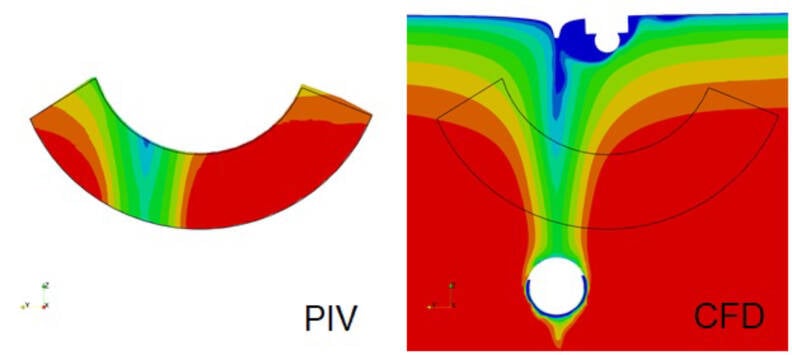
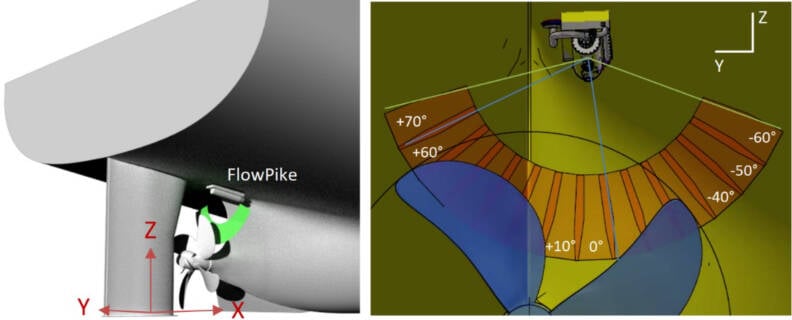
MARIN performed full-scale PIV measurements aboard a 50k DWT tanker using our unique FlowPike PIV device in 2022. The measurements were executed within the JoRes JIP, with the aim of generating a high-quality wake-field dataset to be used for comparison with CFD.
In July 2024, the first PIV-CFD comparison using this dataset was presented at the 21stInternational Symposium on Application of Laser and Imaging techniques to Fluid Mechanics. Here, we quantified the error of the full-scale PIV measurements and made a comparison between the PIV results with the results of a CFD calculation performed using our in-house RANS code ReFresco.
Overall, the comparison is very favourable; the CFD underpredicted the total power required for propulsion by 3.6%. The velocity fields also compared well, with a small difference observed in the axial velocity on the port side of the vessel, which is thought to originate from an insufficiently accurate roughness model.
Interested? Read the paper ‘Comparison of full-scale PIV measurements with CFD simulations of a ship propeller inflow’.
Back to In Short
First PIV-CFD comparison using high-quality wake-field dataset









Back to In Short
Lloyd, T., Lafeber, F. H., Bosschers, J.,
Inter-Noise, Nantes, France, Aug 25, 2024
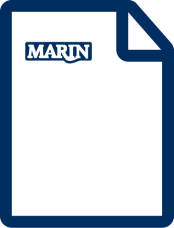
Calvert, R., Peytavin, A., Pham, Y., Duhamel, A., Zanden, J. van der, Essen, S. M. van, Sainte-Rose, B., Bremer, T. S. van den, Journal of Geophysical Research: Oceans, Volume 129

Willemsen, C., Toxopeus, S. L., Quadvlieg, F., 35th Symposium on Naval Hydrodynamics, Nantes, France, Jul 8, 2024


October 2024, no. 141

Nov.
19-20
HISWA Symposium
Conferences
Nov.
18-22
Floating Energy Research
Forum
Networking
Nov. 7
SmartPort Summit water & De haven
Seminars
Nov.
4-6
Hydrodynamics of Floating Offshore Structures
Cources
MARIN will be present at the following events. Let’s meet up again soon!






Create a MARIN account to stay updated

Report
MARIN presentation on the TopTier project’s results during the CCC (10) plenary meeting.

Back to In Short
This year, the Blue Forum and the Vessel Operator Forum joined forces to organise the 12th edition of the BlueWeek in Italy.
More than 200 delegates from over 20 countries participated in the BlueWeek that was hosted by ACTV, the Venetian public transportation company, and VELA. All the seminars and project meetings took place in the Arsenale of Venice.
Delegates were delighted to have the privilege to visit the MOSE installation that protects the city and the laguna from rising water levels.
As well as the seminars on Renewable Marine Energy, Maritime Spatial Planning & Multi-use (co-organised with the European Blue Forum), Infrastructure & Operations, Natural Propulsion and Zero Emission Technologies, several project meetings took place during the week: Top Tiers, FC-series, WISP2 and the members meeting of the IWSA. We also kicked-off two new projects, the Tripping JIP, which attracted 11 participants, and the third phase of wind propulsion JIP - WISP3 - with a total of 28 participants. Those new initiatives are still open for additional participants.
The 2025 edition will be held in April and hosted by MARIN at its Wageningen HQ. For the latest updates, presentations and news, please check www.blueforum.org
Prevention of container losses at the IMO
PIV and CFD results comparison for the same measurement conditions. The PIV measurement area is outlined in black in the CFD figure.
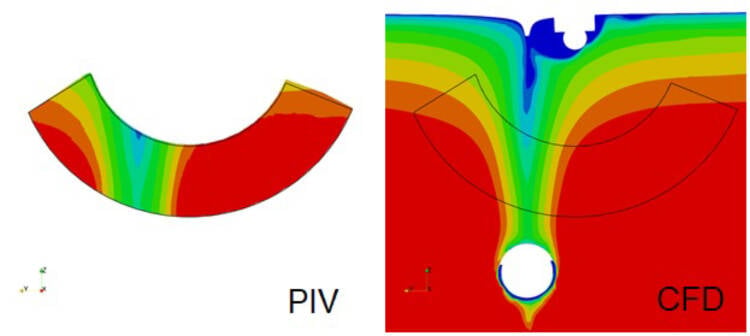
Left: 3D model of the FlowPike fixed to the vessel used in the trial.
Right: View from the aft, showing the measurement area of the FlowPike.

MARIN performed full-scale PIV measurements aboard a 50k DWT tanker using our unique FlowPike PIV device in 2022. The measurements were executed within the JoRes JIP, with the aim of generating a high-quality wake-field dataset to be used for comparison with CFD.
In July 2024, the first PIV-CFD comparison using this dataset was presented at the 21stInternational Symposium on Application of Laser and Imaging techniques to Fluid Mechanics. Here, we quantified the error of the full-scale PIV measurements and made a comparison between the PIV results with the results of a CFD calculation performed using our in-house RANS code ReFresco.
Overall, the comparison is very favourable; the CFD underpredicted the total power required for propulsion by 3.6%. The velocity fields also compared well, with a small difference observed in the axial velocity on the port side of the vessel, which is thought to originate from an insufficiently accurate roughness model.
Interested? Read the paper ‘Comparison of full-scale PIV measurements with CFD simulations of a ship propeller inflow’.
First PIV-CFD comparison using high-quality wake-field dataset
Back to In Short
Back to In Short
Calvert, R., Peytavin, A., Pham, Y., Duhamel, A., Zanden, J. van der, Essen, S. M. van, Sainte-Rose, B., Bremer, T. S. van den, Journal of Geophysical Research: Oceans, Volume 129
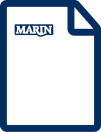
Lloyd, T., Lafeber, F. H., Bosschers, J.,
Inter-Noise, Nantes, France, Aug 25, 2024

Willemsen, C., Toxopeus, S. L., Quadvlieg, F., 35th Symposium on Naval Hydrodynamics, Nantes, France, Jul 8, 2024

